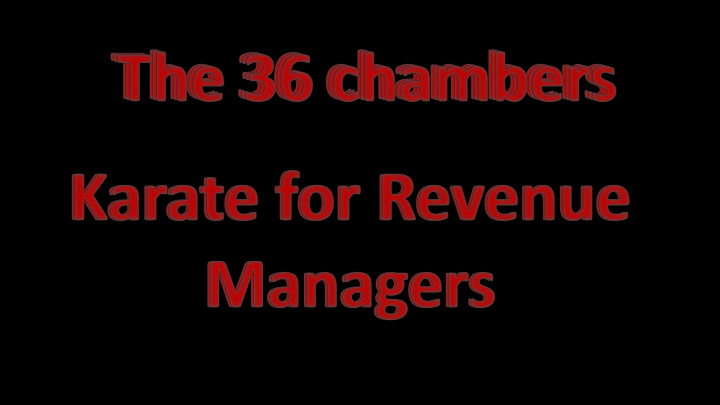



Your Teachers: Katarina Svensson, black belt Oliver Geldner, White Sock
But first you must unlearn what you have learned
Deconstructing Revenue Management Karate for Revenue Managers Ch 1: Forecasting Ch 4: Analysis Ch 2: Strategy CH 3:Implementation
Chamber 5: Fully Manual Revenue Management Forecasting: History, Demand & Events, Pace Strategy: Booking Curve and price points Implementation: Balance Volume vs all Rates Analysis: Performance against market Data resources: PMS data, historic data, rate shopping, benchmarking
Chamber 6: Semi-Automated Revenue Management Forecasting: by day / all year, revenue target by day Strategy: pricing assistance from RM system Implementation: rate overrides open/close inventory Analysis: Performance against market Data resources: PMS data, historic data, rate shopping
Chamber 7: Fully Automated Revenue Management Forecasting: by day / all year, revenue target by day, history, demand, booking pace Strategy: multiple booking curves, matching days (from history) Implementation: RM system runs all rate decisions and inventory control, restrictions, last room value Data resources: PMS data, historic data, rate shopping (as indicator) applied against algorythms
Chamber 8: What does a revenue system do ? Market Segmentation Historical Demand & Booking Patterns Demand Forecast & Displacement Pricing & Inventory Overbooking Information systems / secondary data (benchmarks)
Chamber 9: What differentiates the systems ? Weight of
Chamber 16 : Basic Algorythms =period(days) = Price of room/segment Rate = Projected demand at price p = REV/OCC index from previous/similar nights (=elasticity) Demand (=forecasted occupany) (=forecasted rate)
Chamber 19: phylosophy PMS rate ladders and RM systems don’t mix ! = Quantity based rate decisions misinterpret demand RM systems apply ”open pricing” based on ”last rooms value” RM systems optimize inventory at best rate (overbooking on room category in relation to demand
Chamber 20: phylosophy Systems with higher weight on historic data and matching days: IDEAS, EZRMS, Duetto, Xotel Systems with higher emphasis on booking pace: Atomize, PriceMyHotelRoom, Pace
Chamber 21: Advantages with RM solutions RevPAR increase following installation of any RM often due to: - better availability / inventory management - frequent rate updates - quicker decision process - no limitations, no product/value perception
Chamber 22: Advantage with Manual Process More creative in achieving ADR - less static handling - better product/value perspective - quicker to pick up on deviations in market - more detailed focus on single room
Chamber 23 : Position of Revenue Solutions # of Roomss IDEAS Atomize Pace Duetto EZRMS PMHR Quality & Quantity of PMS HQPlus data Lybratech OTAinsight Rate Intelligence
Chamber 24 : Position of Revenue Solutions Manual adjustments HQPlus IDEAS Duetto OTAinsight Rate EZRMS Intelligence Seconday datas Lybratech PMHR Pace Atomize
Chamber 25: Dashboards - Don’t get blindsighted by the fact they exist - Dashboards build on data and KPIs - Look & Feel is secondary to Data & Source
Chamber 29: Speed of punch - Requirement based on market dynamics - Frequency of data exchange - Frequency of calculations - Frequency/Speed of output - In relation to your pace/pickup
Chamber 34 to 36 : Pricing & Distribution layers Who runs your show? - Is the PMS Master of your domain ? - Or is the Channel Manager ? - Which entity provides data and which distributes ?
Recommend
More recommend